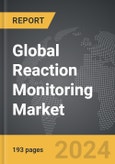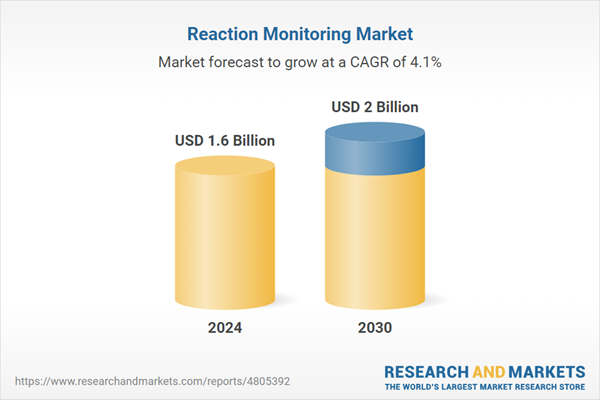The global market for Reaction Monitoring was valued at US$1.6 Billion in 2024 and is projected to reach US$2.0 Billion by 2030, growing at a CAGR of 4.1% from 2024 to 2030. This comprehensive report provides an in-depth analysis of market trends, drivers, and forecasts, helping you make informed business decisions. The report includes the most recent global tariff developments and how they impact the Reaction Monitoring market.
Segments: Technology (Spectroscopy, Chromatography, Calorimetry, Titrimetry, X-Ray Diffraction); Reaction Mode (Quantitative, Qualitative); End-Use (Pharmaceutical, BioPharma & Biotech Companies, Life Sciences & Genomic Research Facilities, Food & Beverage, Pollution Monitoring & Control, Other End-Uses).
Geographic Regions/Countries: World; United States; Canada; Japan; China; Europe (France; Germany; Italy; United Kingdom; and Rest of Europe); Asia-Pacific; Rest of World.
The analysts continuously track trade developments worldwide, drawing insights from leading global economists and over 200 industry and policy institutions, including think tanks, trade organizations, and national economic advisory bodies. This intelligence is integrated into forecasting models to provide timely, data-driven analysis of emerging risks and opportunities.
Global Reaction Monitoring Market - Key Trends and Drivers Summarized
Reaction Monitoring: Crucial for Precision in Chemical Processes
Reaction monitoring is a critical process in the chemical and pharmaceutical industries, enabling scientists and engineers to track the progress of chemical reactions in real-time and ensure that the desired products are formed efficiently and safely. By monitoring key parameters such as temperature, pressure, pH, and the concentration of reactants and products, reaction monitoring helps optimize reaction conditions, prevent side reactions, and improve yields. In pharmaceutical manufacturing, where precision and consistency are paramount, reaction monitoring ensures that each batch of a drug meets the required quality standards. This process is also essential for identifying and controlling potential safety hazards, such as runaway reactions or the formation of toxic byproducts. The ability to monitor and adjust reactions in real-time is crucial for achieving high levels of precision, efficiency, and safety in chemical processes.How Are Technological Advancements Enhancing Reaction Monitoring Techniques?
Technological advancements are significantly enhancing reaction monitoring techniques, making them more accurate, sensitive, and capable of providing real-time data on complex chemical processes. The development of advanced spectroscopy methods, such as infrared (IR) and nuclear magnetic resonance (NMR) spectroscopy, has improved the ability to monitor the molecular changes occurring during reactions, allowing for detailed analysis of reaction mechanisms and kinetics. The integration of real-time analytics and process analytical technology (PAT) into reaction monitoring systems has further enhanced the ability to control and optimize chemical processes on-the-fly. Additionally, the use of miniaturized sensors and microfluidic devices has enabled reaction monitoring in small-scale, high-throughput settings, which is particularly valuable in pharmaceutical research and development. These technological innovations are making reaction monitoring more efficient, enabling faster and more accurate data collection, and allowing for more precise control of chemical processes.What Are the Key Applications and Benefits of Reaction Monitoring in Industry?
Reaction monitoring is used in a wide range of applications within the chemical, pharmaceutical, and materials industries, offering significant benefits that enhance process control, safety, and product quality. In chemical manufacturing, reaction monitoring is essential for optimizing reaction conditions, maximizing yield, and minimizing waste, contributing to more sustainable and cost-effective production processes. In the pharmaceutical industry, reaction monitoring ensures that active pharmaceutical ingredients (APIs) are produced with the required purity and consistency, reducing the risk of batch failures and ensuring compliance with regulatory standards. In materials science, reaction monitoring is used to study the formation and properties of new materials, enabling the development of advanced materials with tailored characteristics. The primary benefits of reaction monitoring include improved process efficiency, enhanced safety, and the ability to produce high-quality products consistently. These advantages make reaction monitoring an indispensable tool for ensuring the success of chemical processes across various industries.What Factors Are Driving the Growth in the Reaction Monitoring Market?
The growth in the Reaction Monitoring market is driven by several factors. The increasing demand for precision and efficiency in chemical and pharmaceutical manufacturing is a significant driver, as industries seek to optimize their processes and ensure consistent product quality. Technological advancements in analytical instrumentation, such as spectroscopy and real-time analytics, are also propelling market growth by enhancing the capabilities and accuracy of reaction monitoring systems. The rising focus on process safety and the need to comply with stringent regulatory requirements are further boosting demand for advanced reaction monitoring solutions. Additionally, the expansion of the pharmaceutical and specialty chemicals industries, driven by the development of new drugs and materials, is contributing to market growth, as these sectors require sophisticated monitoring techniques to manage complex chemical processes. These factors, combined with continuous innovation in monitoring technologies and process analytics, are driving the sustained growth of the Reaction Monitoring market.Report Scope
The report analyzes the Reaction Monitoring market, presented in terms of units. The analysis covers the key segments and geographic regions outlined below.Segments: Technology (Spectroscopy, Chromatography, Calorimetry, Titrimetry, X-Ray Diffraction); Reaction Mode (Quantitative, Qualitative); End-Use (Pharmaceutical, BioPharma & Biotech Companies, Life Sciences & Genomic Research Facilities, Food & Beverage, Pollution Monitoring & Control, Other End-Uses).
Geographic Regions/Countries: World; United States; Canada; Japan; China; Europe (France; Germany; Italy; United Kingdom; and Rest of Europe); Asia-Pacific; Rest of World.
Key Insights:
- Market Growth: Understand the significant growth trajectory of the X-Ray Diffraction segment, which is expected to reach US$177.6 Million by 2030 with a CAGR of a 2.8%. The Titrimetry segment is also set to grow at 3.8% CAGR over the analysis period.
- Regional Analysis: Gain insights into the U.S. market, valued at $430.1 Million in 2024, and China, forecasted to grow at an impressive 3.9% CAGR to reach $322.7 Million by 2030. Discover growth trends in other key regions, including Japan, Canada, Germany, and the Asia-Pacific.
Why You Should Buy This Report:
- Detailed Market Analysis: Access a thorough analysis of the Global Reaction Monitoring Market, covering all major geographic regions and market segments.
- Competitive Insights: Get an overview of the competitive landscape, including the market presence of major players across different geographies.
- Future Trends and Drivers: Understand the key trends and drivers shaping the future of the Global Reaction Monitoring Market.
- Actionable Insights: Benefit from actionable insights that can help you identify new revenue opportunities and make strategic business decisions.
Key Questions Answered:
- How is the Global Reaction Monitoring Market expected to evolve by 2030?
- What are the main drivers and restraints affecting the market?
- Which market segments will grow the most over the forecast period?
- How will market shares for different regions and segments change by 2030?
- Who are the leading players in the market, and what are their prospects?
Report Features:
- Comprehensive Market Data: Independent analysis of annual sales and market forecasts in US$ Million from 2024 to 2030.
- In-Depth Regional Analysis: Detailed insights into key markets, including the U.S., China, Japan, Canada, Europe, Asia-Pacific, Latin America, Middle East, and Africa.
- Company Profiles: Coverage of players such as Bio-Rad Laboratories, Inc., Bruker Corporation, Danaher Corporation, Hitachi High-Technologies Corporation, Horiba Ltd. and more.
- Complimentary Updates: Receive free report updates for one year to keep you informed of the latest market developments.
Some of the 44 companies featured in this Reaction Monitoring market report include:
- Bio-Rad Laboratories, Inc.
- Bruker Corporation
- Danaher Corporation
- Hitachi High-Technologies Corporation
- Horiba Ltd.
- Merck & Co., Inc.
- Mettler-Toledo International, Inc.
- PerkinElmer, Inc.
- Restek Corporation
- Setaram Instrumentation
- Shimadzu Corporation
- Waters Corporation
Tariff Impact Analysis: Key Insights for 2025
Global tariff negotiations across 180+ countries are reshaping supply chains, costs, and competitiveness. This report reflects the latest developments as of April 2025 and incorporates forward-looking insights into the market outlook.The analysts continuously track trade developments worldwide, drawing insights from leading global economists and over 200 industry and policy institutions, including think tanks, trade organizations, and national economic advisory bodies. This intelligence is integrated into forecasting models to provide timely, data-driven analysis of emerging risks and opportunities.
What’s Included in This Edition:
- Tariff-adjusted market forecasts by region and segment
- Analysis of cost and supply chain implications by sourcing and trade exposure
- Strategic insights into geographic shifts
Buyers receive a free July 2025 update with:
- Finalized tariff impacts and new trade agreement effects
- Updated projections reflecting global sourcing and cost shifts
- Expanded country-specific coverage across the industry
Table of Contents
I. METHODOLOGYII. EXECUTIVE SUMMARY2. FOCUS ON SELECT PLAYERSIII. MARKET ANALYSISCANADAITALYREST OF EUROPEREST OF WORLDIV. COMPETITION
1. MARKET OVERVIEW
3. MARKET TRENDS & DRIVERS
4. GLOBAL MARKET PERSPECTIVE
UNITED STATES
JAPAN
CHINA
EUROPE
FRANCE
GERMANY
UNITED KINGDOM
ASIA-PACIFIC
Companies Mentioned (Partial List)
A selection of companies mentioned in this report includes, but is not limited to:
- Bio-Rad Laboratories, Inc.
- Bruker Corporation
- Danaher Corporation
- Hitachi High-Technologies Corporation
- Horiba Ltd.
- Merck & Co., Inc.
- Mettler-Toledo International, Inc.
- PerkinElmer, Inc.
- Restek Corporation
- Setaram Instrumentation
- Shimadzu Corporation
- Waters Corporation
Table Information
| Report Attribute | Details |
|---|---|
| No. of Pages | 193 |
| Published | April 2025 |
| Forecast Period | 2024 - 2030 |
| Estimated Market Value ( USD | $ 1.6 Billion |
| Forecasted Market Value ( USD | $ 2 Billion |
| Compound Annual Growth Rate | 4.1% |
| Regions Covered | Global |









